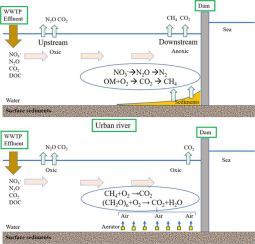当前位置:
X-MOL 学术
›
J. Hydrol.
›
论文详情
Our official English website, www.x-mol.net, welcomes your
feedback! (Note: you will need to create a separate account there.)
Greenhouse gases in an urban river: trend, isotopic evidence for underlying processes, and the impact of in-river structures
Journal of Hydrology ( IF 5.9 ) Pub Date : 2020-12-01 , DOI: 10.1016/j.jhydrol.2020.125290 Xing Li , Huaiying Yao , Yongxiang Yu , Yingjie Cao , Changyuan Tang
Journal of Hydrology ( IF 5.9 ) Pub Date : 2020-12-01 , DOI: 10.1016/j.jhydrol.2020.125290 Xing Li , Huaiying Yao , Yongxiang Yu , Yingjie Cao , Changyuan Tang

|
Abstract Urban rivers are important sources of greenhouse gases (GHGs) to the atmosphere; however, these high dissolved GHGs are not well studied. We report the first detailed investigation on an urban river influenced by wastewater treatment plant (WWTP), dam and aeration device, with a focus on the concentration of GHGs and their underlying microbial processes basing on isotope approaches. The result revealed that these infrastructures influenced carbon and/or nitrogen input and redox condition of the river system, leading to impaction of GHGs concentrations and spatiotemporal pattern. The WWTP effluent was the point-source of N2O loading to rivers, and also contained high NO3– and dissolved organic carbon, creating favorable conditions for denitrification by microbes. We measured isotopic compositions (δ15N-N2O and δ18O-N2O) and site preference (SP) of dissolved N2O to differentiate the relative contribution of N2O production processes and calculate the degree of N2O reduction (Fr). The relative contribution of denitrification increased at downstream and Fr suggested that N2O was produced and consumed by heterotrophic denitrification, resulting in a sink of N2O downstream. The closure of dam increased water residence time, trapped the sediment, accelerated oxygen consumption, and development of anoxic conditions that stimulating the production of CO2 and CH4, as well as consumption of N2O. Aeration devices maintained oxic condition, that slowing the development of the anoxic stage and eliminating the methanic stage at downstream. As a result, CO2 concentrations increased along the river due to production of CO2 via anaerobic and aerobic respiration of aqueous organic matter. CH4 concentrations increased at downstream from organic matter biodegradation under anoxic conditions. The measured dissolved GHGs, especially the upper ranges, correspond to a large oversaturation of surface water with respect to atmospheric equilibrium, leading high fluxes to the atmosphere. Our values are on the high end of estimates reported in the literature among different climate regions, indicating that urban river influenced by various of infrastructures are comparable to those in wetlands and intensively agricultural rivers in terms of GHGs emissions. Urban river should be urgently included in the determination of global carbon and nitrogen budgets from rivers.
中文翻译:

城市河流中的温室气体:趋势、潜在过程的同位素证据以及河内结构的影响
摘要 城市河流是大气中温室气体 (GHG) 的重要来源。然而,这些高溶解温室气体并未得到很好的研究。我们报告了对受污水处理厂 (WWTP)、大坝和曝气装置影响的城市河流的首次详细调查,重点是温室气体的浓度及其基于同位素方法的潜在微生物过程。结果表明,这些基础设施影响了河流系统的碳和/或氮输入和氧化还原条件,从而影响了温室气体浓度和时空格局。污水处理厂出水是河流中 N2O 负荷的点源,还含有大量的 NO3 和溶解有机碳,为微生物反硝化创造了有利条件。我们测量了溶解的 N2O 的同位素组成(δ15N-N2O 和 δ18O-N2O)和位点偏好 (SP),以区分 N2O 生产过程的相对贡献并计算 N2O 的减少程度 (Fr)。下游反硝化的相对贡献增加,Fr 表明 N2O 是由异养反硝化产生和消耗的,导致下游 N2O 汇。大坝关闭增加了水的停留时间,截留了沉积物,加速了氧气消耗,并形成了刺激 CO2 和 CH4 产生以及 N2O 消耗的缺氧条件。曝气装置保持好氧条件,减缓缺氧阶段的发展,消除下游的甲烷阶段。因此,由于通过水性有机物质的厌氧和有氧呼吸产生 CO2,沿河的 CO2 浓度增加。在缺氧条件下,有机物生物降解下游的 CH4 浓度增加。测得的溶解温室气体,尤其是上限,对应于相对于大气平衡的地表水大量过饱和,导致高通量进入大气。我们的值处于不同气候区域文献中报告的估计值的高端,表明受各种基础设施影响的城市河流在温室气体排放方面与湿地和集约化农业河流中的河流相当。城市河流应紧急纳入全球河流碳和氮收支的确定。
更新日期:2020-12-01
中文翻译:

城市河流中的温室气体:趋势、潜在过程的同位素证据以及河内结构的影响
摘要 城市河流是大气中温室气体 (GHG) 的重要来源。然而,这些高溶解温室气体并未得到很好的研究。我们报告了对受污水处理厂 (WWTP)、大坝和曝气装置影响的城市河流的首次详细调查,重点是温室气体的浓度及其基于同位素方法的潜在微生物过程。结果表明,这些基础设施影响了河流系统的碳和/或氮输入和氧化还原条件,从而影响了温室气体浓度和时空格局。污水处理厂出水是河流中 N2O 负荷的点源,还含有大量的 NO3 和溶解有机碳,为微生物反硝化创造了有利条件。我们测量了溶解的 N2O 的同位素组成(δ15N-N2O 和 δ18O-N2O)和位点偏好 (SP),以区分 N2O 生产过程的相对贡献并计算 N2O 的减少程度 (Fr)。下游反硝化的相对贡献增加,Fr 表明 N2O 是由异养反硝化产生和消耗的,导致下游 N2O 汇。大坝关闭增加了水的停留时间,截留了沉积物,加速了氧气消耗,并形成了刺激 CO2 和 CH4 产生以及 N2O 消耗的缺氧条件。曝气装置保持好氧条件,减缓缺氧阶段的发展,消除下游的甲烷阶段。因此,由于通过水性有机物质的厌氧和有氧呼吸产生 CO2,沿河的 CO2 浓度增加。在缺氧条件下,有机物生物降解下游的 CH4 浓度增加。测得的溶解温室气体,尤其是上限,对应于相对于大气平衡的地表水大量过饱和,导致高通量进入大气。我们的值处于不同气候区域文献中报告的估计值的高端,表明受各种基础设施影响的城市河流在温室气体排放方面与湿地和集约化农业河流中的河流相当。城市河流应紧急纳入全球河流碳和氮收支的确定。











































 京公网安备 11010802027423号
京公网安备 11010802027423号